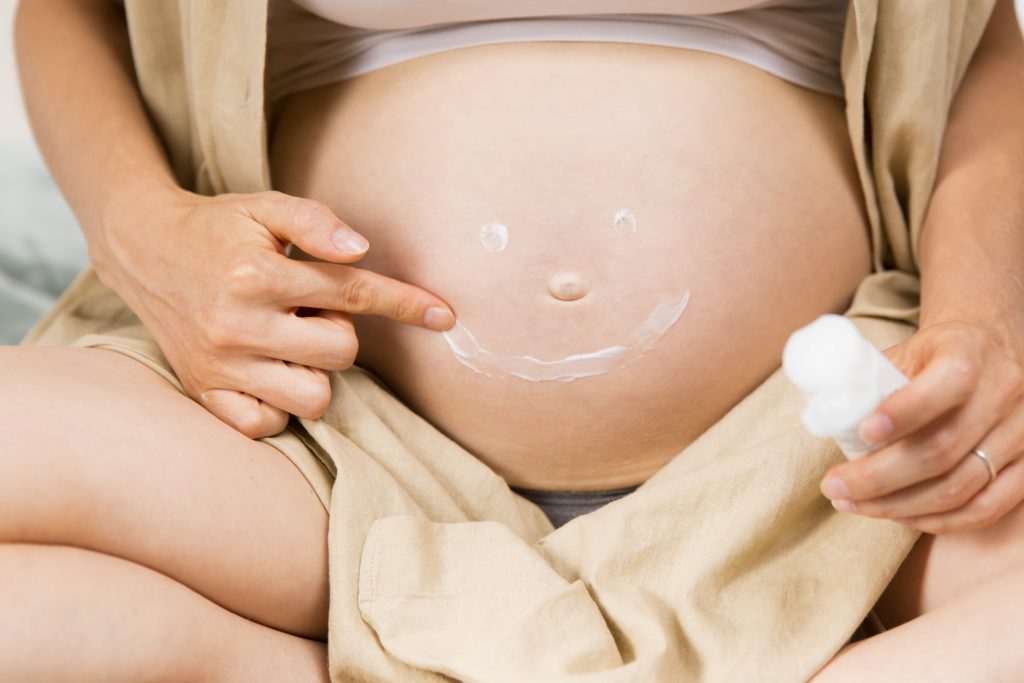
Skincare in pregnancy – Have you ever stopped to think how the largest organ in the human body, the skin, reacts to pregnancy changes? Like the other parts of the body, the woman’s skin feels all the physical and hormonal changes during and after pregnancy, so it is common to notice changes that range from skin pigmentation to the aspect of the nail.
Pregnancy dermatoses can be classified into three groups: physiological skin changes, pre-existing problems that worsen with pregnancy and skin problems inherent to pregnancy. This means that, besides the common alterations, women with genetic predisposition or some specific problem can present manifestations in the dermis.
The main physiological skin changes of pregnancy are: stretch marks and pigmentary changes, such as melasma; hair changes, glands (acne), vascular changes (varicose veins) and nails. Although these changes are not considered ‘diseases’, their unesthetic appearance can cause suffering to the pregnant woman. And the psychological suffering of the mother certainly influences the fetal development,
A recurring question during pregnancy is: how to continue taking care of the skin without harming the baby? This concern is fair, because some dermocosmetics, when applied to the skin, can be absorbed even by the bloodstream – which can bring problems to the health of the fetus. The good news is that it is possible to continue with the beauty routines, but opting for safe products and actives, duly indicated by dermatologist.
The triad of care that involves hygienization, hydration and photoprotection is still necessary, besides the anti-aging treatment. The difference is that, in this phase, there are more specific products.
Hygiene: the hormonal oscillations typical of this period tend to cause the appearance of carnations and pimples, besides the consequent increase of oiliness – even for women who never had this problem. Pregnant women should opt for products that are able to alleviate acne, clear the pores and reduce oil production, but never use high-frequency aesthetic devices, peelings with acids and application of botulinum toxin.
Hydration: among the actives that hydrates, conserves the protective barrier of the skin, and diminishes the risk of stretch marks, stimulate the production of collagen and are allowed for pregnant women, thermal water, shea butter, glycerin, almond/mineral oils and hyaluronic acid appear. The hydration must be complemented with the ingestion of a lot of liquid. Actives with urea above 3% in the formula are forbidden, because they increase the absorption capacity of the skin.
Photoprotection: important to prevent melasma spots, dryness, precocious cutaneous ageing and even cancer. Here the sun filters should have SPF superior to 50 and the physical protectors, such as hats, sunglasses and umbrella should be even more important.
Anti-ageing: The benefits of anti-ageing treatments do not matter if the woman is pregnant or not, but during pregnancy the skin needs more attention and care. Therefore, it is a good artifice to leave the skin healthy, luscious and smooth. The active hyaluronic acid, zinc, antioxidants, vitamins C and E are ideal for this purpose. The salicylic and retinoic acids are forbidden at this stage. They promote the cellular renovation by the scaling, increasing the dilatation of the vessels. The skin becomes more reactive during pregnancy and can react with hypersensitivity. The tip, then, is to use softer components.
Besides the obstetrician, it is important to include the dermatologist during pregnancy. This way, the pregnant woman will be able to ensure the care of her skin without affecting the pregnancy.
Skin care during pregnancy: how to prevent melasms, stretch marks and oiliness
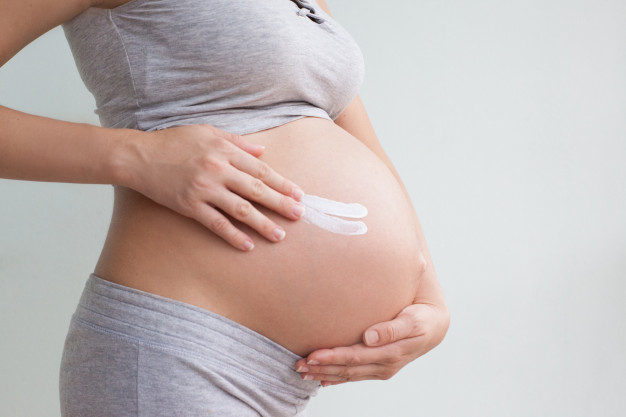
As most aesthetic treatments are forbidden during pregnancy, the best way to avoid these problems is with prevention and daily skin care.
During pregnancy, besides the emotions and anxiety for the arrival of the baby, your body goes through many changes. Pregnancy causes hormonal changes in women. These changes, besides the known nausea in the first months, can also favor the appearance of some marks on the skin. Pregnant women usually face the appearance of cellulite, stretch marks, flaccidity, melasmas, stretch marks and varicose veins.
As most aesthetic treatments are forbidden during pregnancy, the best way to avoid these problems is with prevention and daily skin care. It is possible to stay away from the dreaded stretch marks and melasmas and keep your self-esteem up there during and after pregnancy with some simple tips.
How to prevent stretch marks?
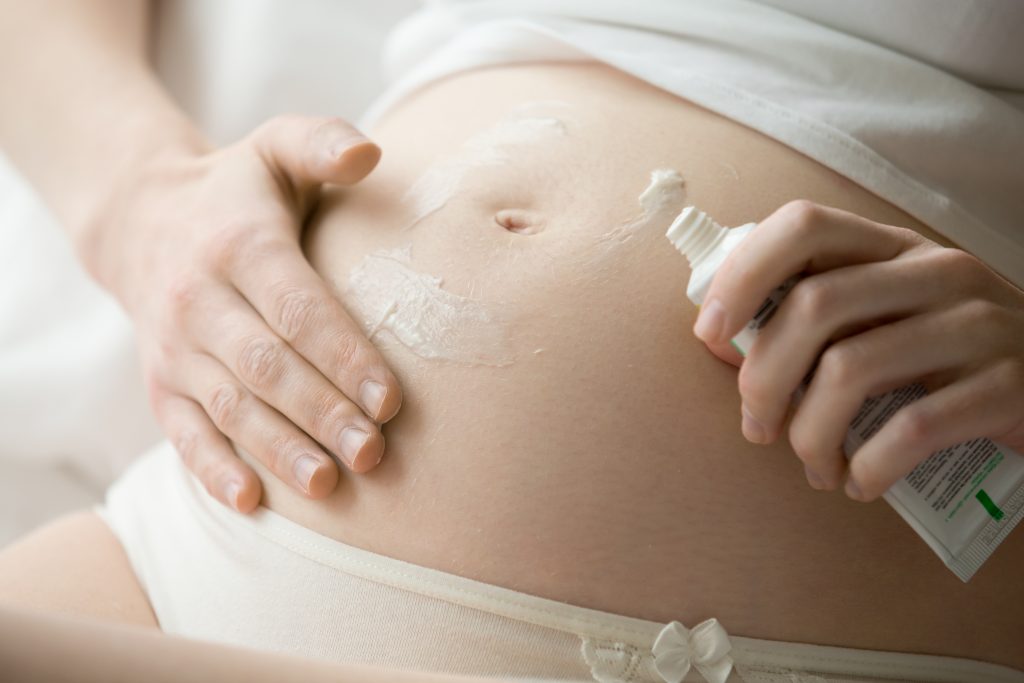
Did you know that stretch marks reach up to 90% of pregnant women, especially near the 25th week of gestation, when the uterus reaches four times its size? As stretch marks appear after an abrupt stretching of the skin, the tip is to maintain a healthy diet and not get too fat during pregnancy. Besides the increase of the belly by pregnancy, women are more prone to fattening and stretch marks can appear in other areas of the body, such as flanks, thighs, buttocks and breasts.
While controlling your diet, it is also important to take good care of your skin. Along with a balanced diet and physical activities, specialists point out that the use of moisturizing creams helps in the prevention of stretch marks, besides bringing benefits for the maintenance of skin quality. Studies with topical application products show that this can improve physical properties and are related to skin elasticity. This way, women will have a greater facility to stretch the skin and reduce the appearance of these stretch marks. It is indicated (always consult a dermatologist) the use of specific moisturizers for pregnant women since the first trimester of pregnancy. Hydrate the skin is important, but you will also need to drink plenty of water this keeps the tissues well nourished, besides helping in the formation of the amniotic fluid.
How to avoid melasmas?
Up to 90% of pregnant women have spots on their skin. This data, allied to the fact that they hardly disappear, usually worries future mothers. The famous spots on the skin are called melasmas, more specifically cloasmas, when related to pregnancy. Dark brown in color, they usually appear on the face, cheeks, nose and upper lips.
They usually appear during the first three months of pregnancy and are accentuated at the end. They are not permanent, but can take up to two years to disappear, depending on the depth of the melasma. To prevent this, do not expose yourself directly to the sun, wear sunglasses, a hat and always apply a photo protector, at least factor 30. After the breast-feeding period, the dermatologist may indicate some lightening cream.
How to avoid skin greasiness?
During pregnancy, the skin can become more oily (Oily skin is an occurrence when the sebaceous glands in the skin produce sebum above normal. Sebum is the waxy and oily substance that protects and moisturizes the skin) and prone to the appearance of acne. Therefore, it is important to wash the face twice a day, preferably in the morning and evening, with pH neutral soap or mild cleansing lotions, which remove the excess oil without drying it out. Common soaps can irritate the skin and should be avoided. When used on oily skin they tend to stimulate the gland to produce more fat.
In the case of dry skin, they increase the dryness considerably. Speaking of water temperature, it should be from warm to cold to not remove the natural greasiness of the skin. Besides cleaning, it is also essential to keep the skin hydrated and protected against the sun, using products that are safe for pregnant women and have dry touch or matte effect on the skin. If the acnes appear, in addition to this care, it is important to seek a dermatologist for a more specific orientation. Many products used to treat acne are prohibited during pregnancy.
Care for you and your baby
To take good care of your skin in a way that is totally safe for the baby, it is important to choose specific products for pregnant women or that doesn’t offer any risk to the fetus. In the case of stretch marks prevention, avoid lotions with high urea concentration (above 3%), which can affect the baby development in utero.
For the prevention of melasmas, it is essential to apply a photoprotector daily on the face. Ideal for women with normal or dry skin, the Filtrum Color has broad spectrum of protection UVA, UVB and visible light. Besides, it has a base color to uniform the skin tone and make your life easier – after all, it’s always good to have a product that is two in one! It also has lightening actives that collaborate for skin lightening and is indicated for pregnant women who already have a history of melasma even before pregnancy.
Pregnancy: 10 tips to take care of beauty during the nine months
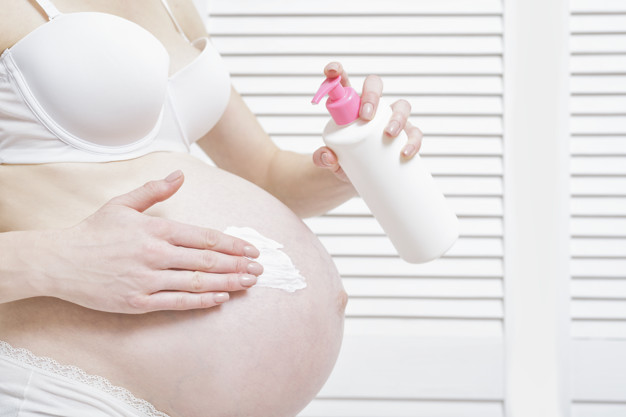
1. Dyeing the hair
The pregnant woman can use dye, as long as she takes some care. It is important to avoid tinctures in the first trimester of pregnancy. Try to use the temporary touch-up sticks. If you have chosen the blonde color, the golden reflections – which usually do not touch the scalp – are also safe. But if it is possible, avoid painting during this period, it is the safest way.
2. Straightening your hair
The pregnant woman should avoid this type of treatment. Today, unfortunately, there is an infinity of products for this purpose, which doesn’t have its formula components truly known. Besides everything, hair structure changes a lot during pregnancy and also on the postpartum period, which can bring unwanted or unfavorable results. It is preferable to opt for the common hydrations and use of brush and dryer to comb. It is safer.
3. Skin Cleansing
According to dermatologists, every pregnant woman can do skin cleaning without any problem. It is a skin that usually already blemishes more easily and so one must be more careful. It is good to avoid the use of exfoliating products containing acids, because the skin absorbs them. It is also important to apply sunscreen soon after cleaning, because the skin becomes thinner and with this is a greater chance of staining. You can’t use any kind of product over the skin – because it can contain substances not ideal for the baby, such as salicylic acid, antibiotics and depigmentants.
4. Skin stains
During pregnancy the spots on the skin are caused by the great increase in female hormones and maintained by heat and sun. It is therefore important to avoid the sun during pregnancy. Besides applying a lot of sunscreen, one can use only botanical whitening cosmetics, with skin whitening complex and alpha arbutin substances. After pregnancy, you can treat the stains, even during breastfeeding, with intense pulsed light, alpha peel and, only after breastfeeding, you can use acids such as retinoic, glycolic and hydroquinone.
5. Stretch marks
The main tip to avoid stretch marks is to keep the proper weight throughout the pregnancy and thus avoid putting on weight suddenly or excessively. If possible, do some kind of exercise and keep the skin hydrated, with soaps and creams indicated by your obstetrician or dermatologist. Stretch marks already present do not alter the pregnancy, because there has already been rupture of the fibers and the place will not be affected again. However, they can work as an alert for the need of greater care, because they indicate a skin prone to develop them.
6. Varicose veins
Again, avoid excessive weight gain, do not stand or sit for long periods, try to have a night rest period of at least 8 hours and do physical exercises such as swimming and hydro gymnastics. Avoid some weight training exercises that increase abdominal pressure and lower limbs, and wear compression stockings if indicated by your doctor. Medical follow-up is indicated for pregnant women who already have varices.
7. Cellulite
Maintain a routine of physical exercises, balanced diet without excessive weight gain (the ideal is 9 to 12 kg in a single fetus gestation), avoid frying, soft drinks and fatty foods. Try to ingest fibers to maintain the good functioning of the intestine and drink a lot of liquid, so that the urine is always very clear. If possible, do lymphatic drainage with a specialized professional once a week and leave the skin always hydrated. There are good products for topic use that can be used by pregnant women. For those who already have cellulite, it is indicated to do the lymphatic draining twice a week.
8. Physical Exercises
Aerobic exercises (walking and swimming), stretching, yoga (directed), weight training and aquarobics are indicated. The type of exercise, intensity and volume can vary a lot, because it depends on: month of pregnancy, history of physical activity of the pregnant woman, medical recommendations, age of the pregnant woman, type of pregnancy among others.
9. Skin Care
The pregnant woman has to use a lot of sun filter on her face, to avoid melasma, as well as creams with antioxidants with vitamin C and E. On the body, she should use hydrating that has essential oils such as grape seed, macadamia, olive oil or argan, yet, the areas that deserves more attention with the healthy hydrating: belly, breasts, flanks, thighs and buttocks.
10. Diet
During pregnancy there is a need for additional protein for the synthesis of maternal and fetal tissues. All vitamins and minerals are important. In pregnancy, we should give more attention to folic acid, ascorbic acid, calcium, phosphorus, iron, zinc, copper, sodium, magnesium, fluoride, iodine and vitamins B6, A, D, E and K. To meet the needs, it is important to have a diversified diet including cereals, wholemeal products, oilseeds, fruits, vegetables, dairy products and meat in the recommended quantities. Minerals and vitamins have specific functions that ensure the mother’s health and perfect fetal development.
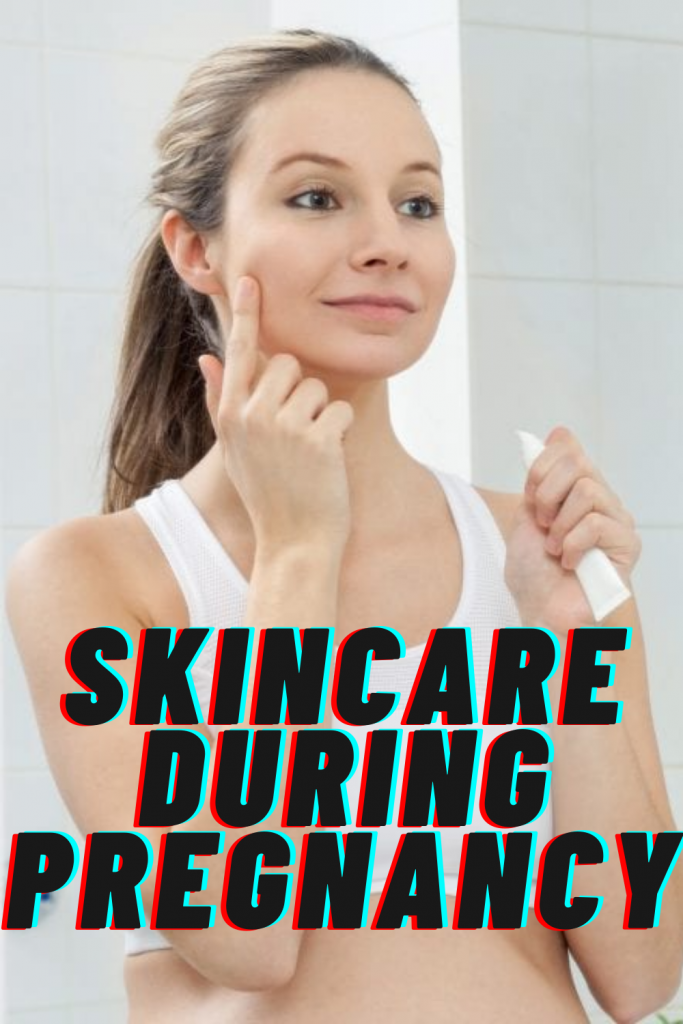
#pregnancyskincare #pregnancyskincare #pregnancysafeskincare #skincareduringpregnancy #skincareduringpregnancy #pregnancyskincareproducts #pregnancyskincareroutine #safeskincareduringpregnancy #safeskincareproductsduringpregnancy #pregnancyskincareroutine #pregnancysafeskincare #skincareforpregnancy #skincarepregnancysafe #skincareroutine #pregnancyskincareproducts #safeskincareforpregnancy #myrealpregnancyskincarerou



